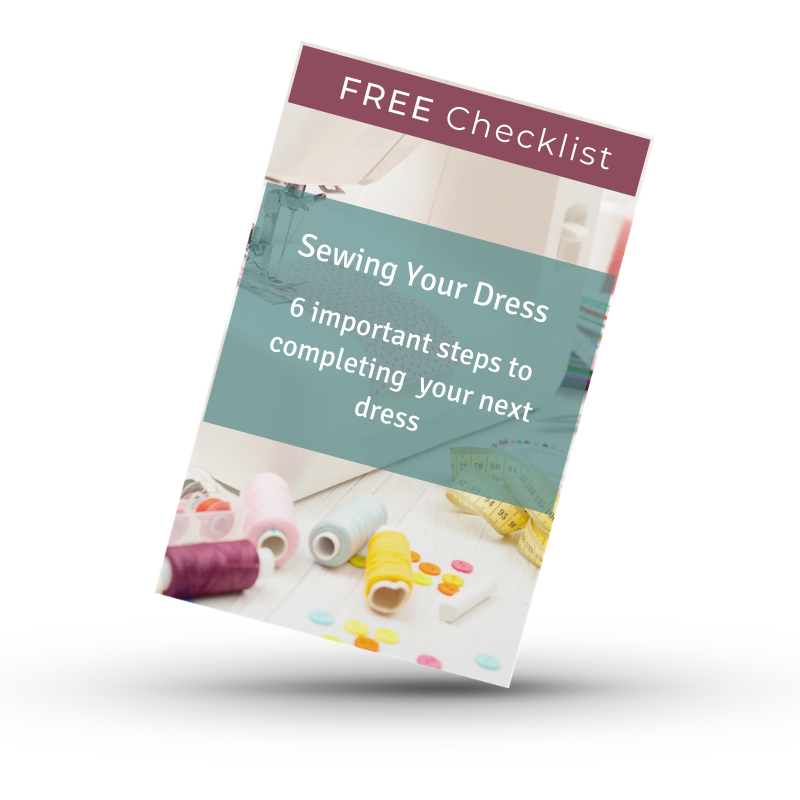
Cutting out a pattern from fabric is the first, most important step of the sewing project. It’s so important because it’s where everything starts and determines the end result.
Before cutting out a sewing project you first need to prepare your pattern and fabric, then lay out the pattern to ensure the pieces fit and that you have enough fabric.
Cutting out can be intimidating. If done right, the result is amazing, but if done wrong, can ruin the whole garment.
In this article we’ll be talking about cutting out dresses but the same steps and tips can be used in sewing any garment.
Make a Plan

First things first, you need a plan.
No, it doesn’t need to be a big plan, but a plan nevertheless.
Making a plan when you have inspiration is the best time. And it can be the most enjoyable part of the whole project because all you need is your imagination!
So plan out your dress. Choose your pattern and plan out any adjustments or add-ons you want to use.
Choose your fabric or go shopping for just the right piece. That matches the fabric recommendations on the pattern, of course.

Because you may end up with a disaster if those two are not matched properly.
If your fabric is woven the pattern needs to be designed for woven fabric for best results. The same goes if you are using knit fabric.
The pattern needs to be designed for knit fabric as well for best results.
And another thing, buy enough fabric. Like, at least as much as the pattern recommends, or more. You would rather have plenty left over than to run out.
A half meter or yard extra isn’t going to break the bank. 😉
And ultimately, if you are trying a new pattern out give it a test run by sewing a dress out of extra fabric before cutting into a special piece.

It’s called sewing a muslin or sewing a test dress and you can learn more about how to do that HERE.
Cutting out a dress has always been the hardest part of sewing for me. So I always try to get it done as quickly as possible.
But that doesn’t always end up in good results. Because I make dumb mistakes.
So making a plan? Well worth it! 😊
One more thing on making a plan is to plan when you are going to cut out. Because you want enough time so that you don’t have to rush it.
Make time so you can take your time. 👍
Prepare the Pattern and Fabric

Prepare your fabric by pre-washing it. Simply throw it in the washer, give it a quick wash with cool or warm water, and dry it in the dryer.
Pre-washing fabric gives it a chance to shrink before you make something out of it and ending up with a dress that is too small.
While the fabric is washing and drying you can prepare your pattern.
Cut it out if you haven’t yet and make any adjustments that are needed to give you the best fit.

If you are using a new pattern you can take this time to get familiar with the pattern pieces as well as the instructions and how the dress gets put together.
If you are the planning type, write down the order that you want to sew the dress together if you like a different order than the instructions give.
Writing down a plan and checking off the steps as you go along will help you stay on track. When you stop and then come back you will know exactly what step to do next.
Gather Tools and Supplies

Next it’s time to gather all your tools and supplies together so that cutting out can be a breeze.
You will need:
- fabric
- pattern
- scissors
- measuring tool
- erasable pen
- pattern weights or pins
Again, make sure your pattern and fabric are going to work well together so that your efforts will not be in vain and your dress will turn out.

Have you ever tried cutting anything with dull scissors? Frustrating.
And very frustrating when cutting out of fabric. So sharp scissors are a must!
Your measuring tool can be a flexible measuring tape or a seam gauge or short ruler of some kind.
I like to use Frixion pens for marking darts and other pattern markings onto the fabric. They erase when ironed and make such nice clear markings.
But you can use a water soluble pen as well.

Weights or pins are needed to keep the pattern pieces in place as you cut around them. No need for anything fancy here. Most of the time I just use table knives to weight my pattern pieces down.
You can also use large metal washers or other things like that that have a nice bit of weight to them.
If you are using fabric that is flimsy or has quite a lot of drape you may want to spray the fabric with spray starch to give it more body as you cut out the pieces.
Gather all your supplies together and place them in a box or ziploc bag so that everything stays together.
Then, when the time comes (the time you planned out) you are ready to cut!
Prepare Your Cutting Area

Oh come on! More preparation?
Well, do you want a good cutting experience or do you want as much frustration as possible?
I am talking from experience. There is nothing more frustrating than diving into a cutting out moment when the space is cluttered which leads to the loss of tools, pattern pieces and sanity.
🤷♀️
So preparing your cutting out space is vital to a good experience and retained sanity.
Whether you cut out on your dining room table, kitchen counter or designated cutting table, it needs to be clear.

Clear, clear. Nothing on it except the tools and supplies you are going to be using.
So remove everything off the surface. And your mind will magically feel more clear as well. Bonus. 🎁
Here is a tip if you are cutting out on a table. Raise the table legs by setting them on some blocks or fitting the legs into some short lengths of plastic pipe.
Raise the table so that you don’t have to bend over while you cut. It saves your back and makes the cutting out experience that much better!
Cut out the Pattern on the Fabric

Finally the time has come to actually cut this thing out!
First of all, fold the fabric in half lengthwise and lay out on the counter or table top. Smooth out wrinkles and ripples that may appear along the folded edge.
Now, start laying out the pattern pieces beginning with the skirt pieces since they are the biggest.
It’s easier to fit the smaller pieces in once the larger pieces are down.
If the pattern pieces have grainline arrows make sure they are facing the length of the fabric and all facing the same direction.

Also take note of the amount of pieces that are required for each pattern piece.
Once you have the pieces laid out, you can either pin them in place or use pattern weights (or table knives) to keep them in place.
And now it’s time to cut!
One little tip on cutting around curves, keep the pattern piece to the back of your cutting hand. This makes it easier to get right close to the pattern.
After cutting out each piece, loosely fold the pattern and fabric together and make a pile of pieces as you cut each on out.

Keeping the pattern with the fabric will help you later as you sew to know exactly which piece is what. It’s easy to mix the back and front skirt or other pieces that look similar to each other.
If there are any darts in the piece you are cutting mark them right away with your Frixion pen or marker. That way, when it’s time to sew you can just sew and not have to mark them then.
Don’t forget to mark the sleeve back as well or other markings that will help you later as you sew. Doing any of this later will slow down the sewing process. Plus it really is easier to do as you cut out.
Once all the pattern pieces are cut out slip them back into the bag or box to sew later, or, sit down at your sewing machine and get started!

Conclusion
Phew! There’s a lot that goes into cutting out a sewing pattern on fabric!
- Make a plan
- Prepare the pattern and fabric
- Gather tools and supplies
- Prepare your cutting area
- Cut out the pattern on fabric
Each detail is important if you want a really good cutting out experience! And I wish you the best experience ever!
Happy cutting!
Maybe you have a cutting out tip that you have come across or have tried that you love. Please share it! I would love to hear it!










I have a question about the pattern I just purchased today…how do I cut out the skirt on the Susan dress? How do I fold my fabric…because to do it lengthwise like it says…well, the skirt is much too wide for that…
To cut out the skirts for the Susan dress you actually need to unfold your fabric before laying out the pattern, and then cut.
I find plastic bed risers from Walmart (you’ll find them in the home goods section often near the laundry baskets; one official use is to raise the bed higher so those with little storage in their house can store things under the bed) to work really well to raise a table to counter height. They work with 8 ft. Lifetime tables and my kitchen table with it’s individual legs but not with my dining room table. Unfortunately I don’t know furniture terms well enough to describe the difference. The bed risers I use stack for storage.
If you need a wider cutting surface, set your ironing board to one side of your table at table height.
Those ideas are awesome. Thank you!